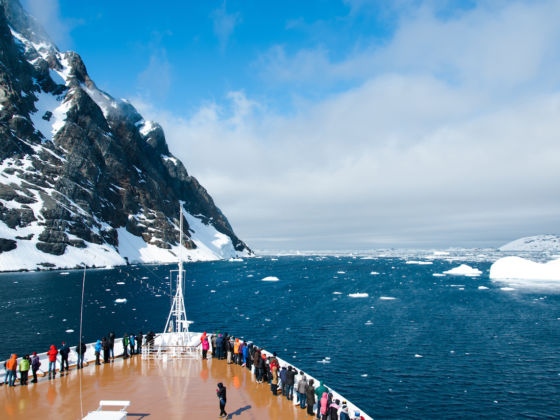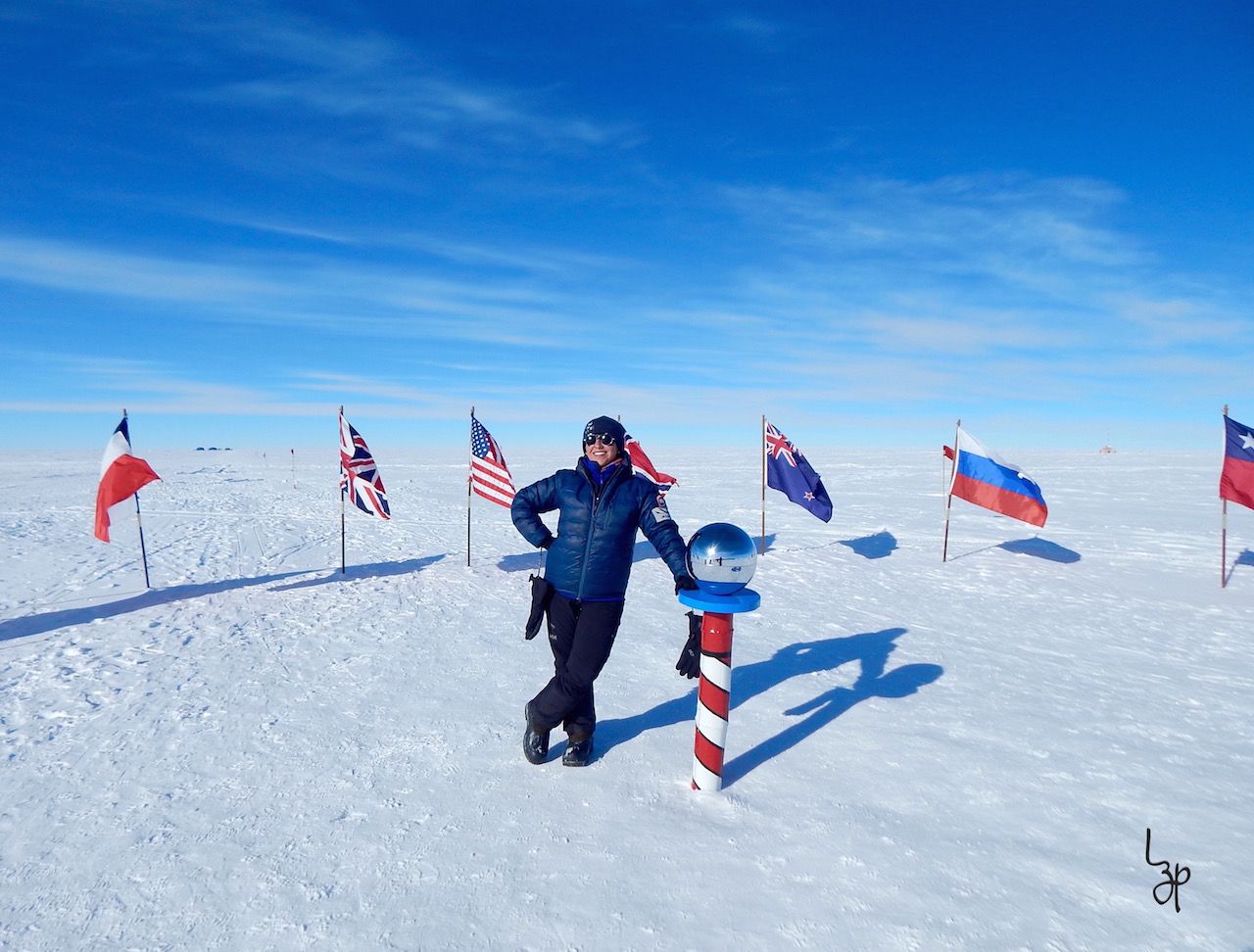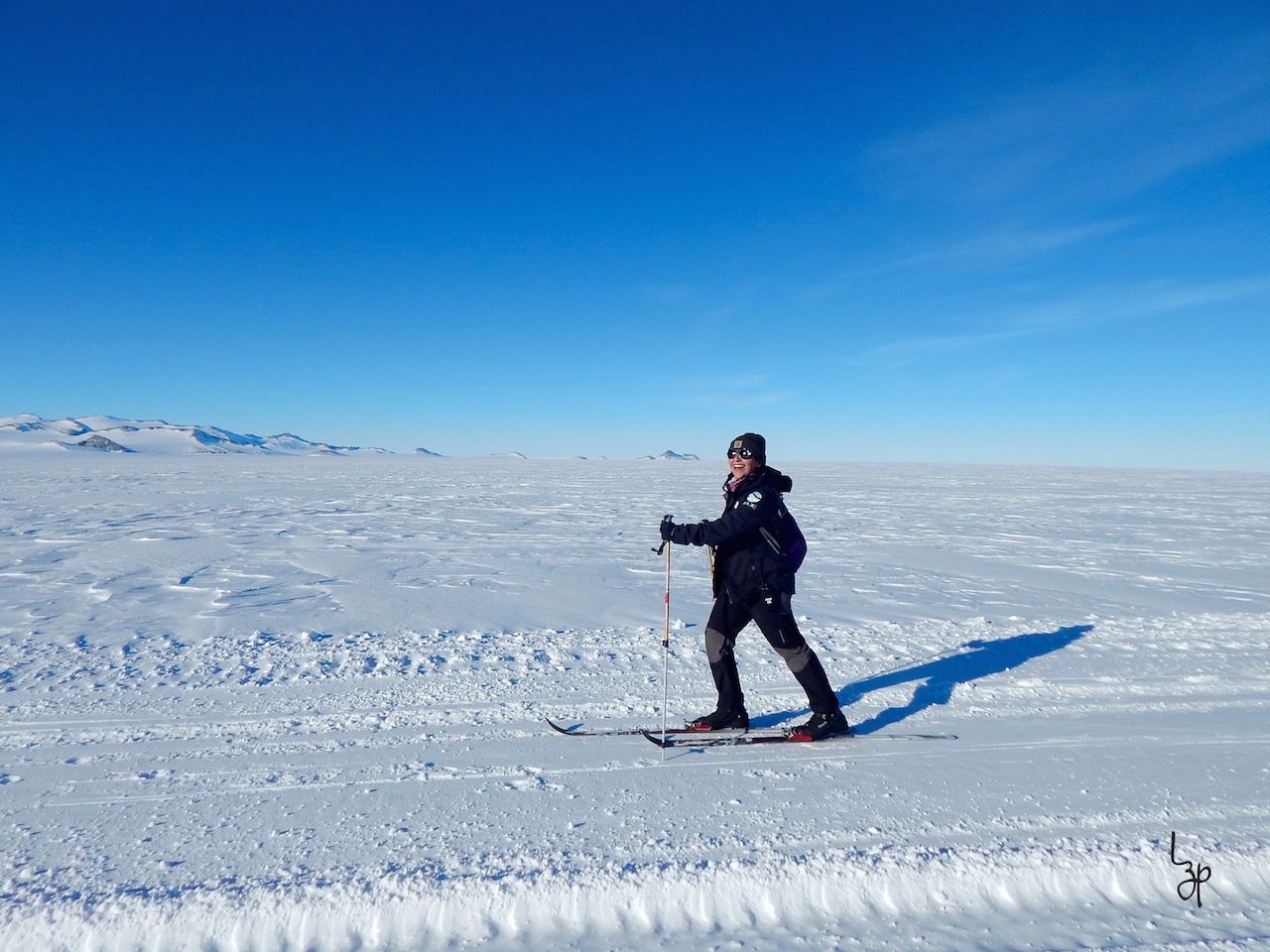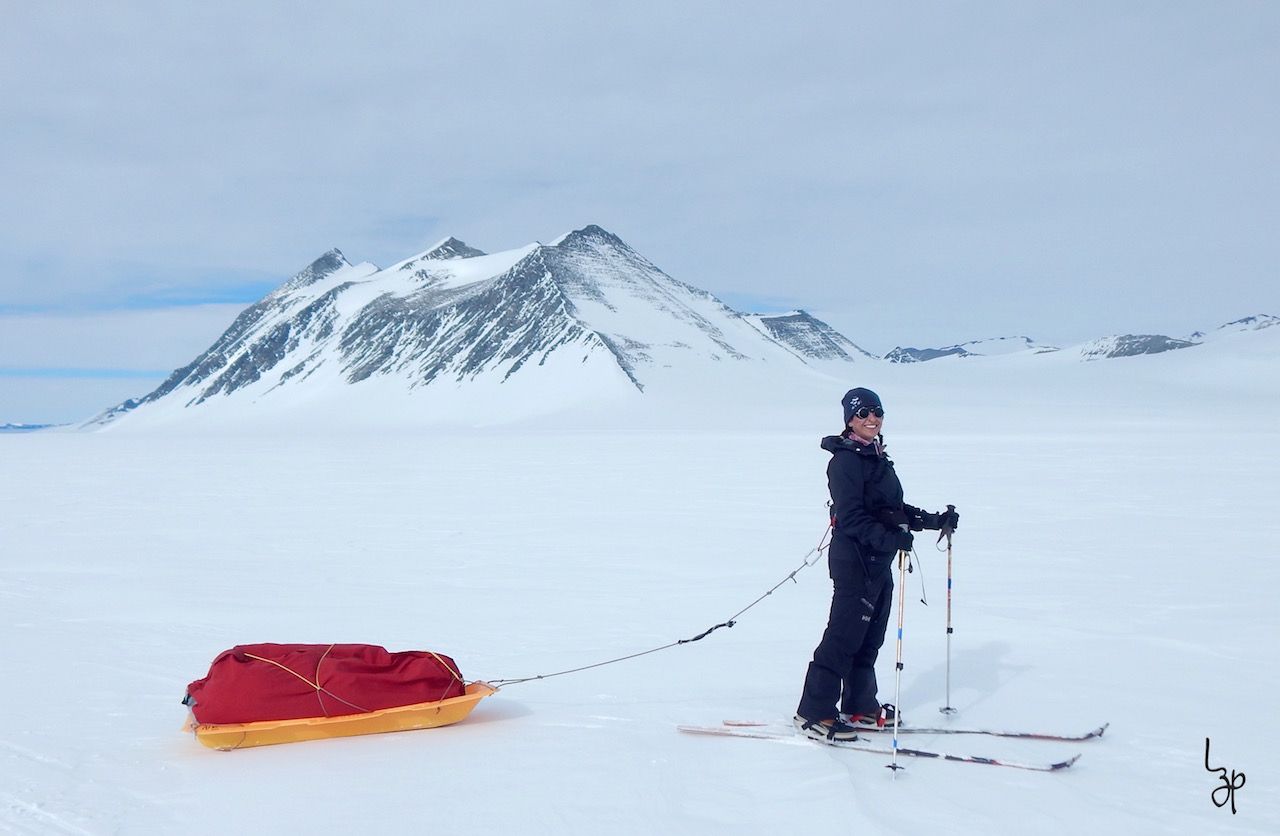Deep inside my -40 degree-rated sleeping bag, my fleece beanie slightly askew above my eye-cover blocking out the incessant sunshine, I curse myself. I really should have practiced using my she-wee (a device that allows women to urinate the way men do) before getting here. I’d been a little shocked to see it along with a “pee bottle” on my employee packing list, but had been quickly informed that these items were necessary for relieving yourself on an excursion outside of camp, where there would be no toilet and no tolerance of spoiling the pristine Antarctic environment. As I was experiencing for the first time, the she-wee/pee bottle combo was also to avoid having to pile on many warm layers to run from your tent to the camp toilet in the middle of the night. More experienced female guides had suggested practicing in the comfort of civilization, and in the mad panic leading up to my arrival on Antarctica, I hadn’t. After that first night, I learned to heed carefully every piece of advice thrown at me about living in Antarctica.


The Ultimate Guide for Planning an Epic Trip to Antarctica
While nothing can fully prepare you for the challenges and wonders of the coldest, driest, and windiest continent, here are some things to consider before traveling to the White Continent.
How to prepare for a successful trip to Antarctica:
1. General info
2. How do I get to Antarctica?
3. What wildlife should I expect to see in Antarctica?
4. What do I need to pack?
5. Working in Antarctica
1. General info

Photo by author
While various protocols and guidelines have been put in place under the Antarctic Treaty System for tourism in Antarctica, the industry is largely self-regulated. In an effort to promote safe and environmentally-responsible practices, seven private tour operators came together in 1991 to found the International Association of Antarctic Tour Operators (IAATO). Today, the organization includes membership of over 100 companies from all around the world. Responsible travelers concerned with minimizing their impact on the fragile environment and wildlife of Antarctica should check that their tour operator is IAATO certified here. The rest of the IAATO site is also worth exploring, as it is full of useful information and helpful tips.
Tourists traveling to the White Continent will be adventuring exclusively during the austral summer season, which lasts from late October/early November to late March/early April. Many travelers will experience 24-hour sunlight — the period of time in which the sun does not set lasts longer the further south you travel. In addition to excessive daylight, Antarctica continually proves itself to be a land of extremes in more ways than one. It is the coldest, driest, windiest continent, with the highest average elevation. It is also an incredibly diverse continent, with a variety of landscapes. “Antarctic tourism” is therefore a broad term, which encompasses travel to the mainland of the continent itself, but can also refer to sub-Antarctic islands such as the South Shetland Islands and South Georgia Island.
While the continent is covered by ice, the islands can include grassy, volcanic landscapes punctuated by glaciers. As such, it is advisable to have a general idea of what it is you want to see, do, and get out of your Antarctic adventure, as the options differ immensely. For example, South Georgia Island is a wildlife hotspot, while the South Pole is located on the flat, white, barren Polar Plateau, devoid of life aside from the American research base located there. Prices for visiting different sites also vary tremendously.
2. How do I get to Antarctica?

Photo by author
One of the hardest parts of traveling to one of the most remote places on the planet is, of course, getting there. For Antarctica, the options are boats or planes (or both). Some of the most common launch points are Ushuaia (Argentina), Punta Arenas (Chile), Cape Town and Port Elizabeth (South Africa), Fremantle/Perth and Hobart (Australia), Invercargill/Bluff (New Zealand).
- By seaAlmost all Antarctic tourism is by boat, which includes a multi-day sea crossing and subsequent coastal exploration, often of the Antarctic Peninsula region. Most cruise-based options depart from South America and last 8-25 days, including a multi-day crossing of the notoriously rough (but occasionally calm) Drake Passage, before exploring the Antarctic Peninsula region and/or sub-Antarctic islands. There is a large range of passenger ship sizes to choose from, generally ranging from 45-280 passengers, each with distinct advantages and disadvantages. For example, larger vessels may provide more onboard entertainment, however, as only 100 passengers may land at once in any single location in Antarctica, passengers on larger ships may not be permitted to go ashore every time, or may be strictly timed to allow multiple groups to land one after the other.
Budget: A typical 10-14 day cruise will generally run you $8,000-$12,000 per passenger. However, many travelers hoping to reach Antarctica for less will try to snag a last-minute spot on a cruise ship, which can significantly lower the price (some just head to places like Argentina and ask if there is room on a ship leaving the very next day — a risky move for sure). Furthermore, things like volunteering to share a triple-occupancy cabin can also help to score you a cheaper spot. Creative, flexible travelers willing to chance a last-minute booking can pay as little as $3,500 per passenger.
- By airFor those looking to avoid the treacherous waters of the Drake Passage and hoping to set foot in interior Antarctica, there are two companies that will fly you into their impressive, remote inland camps.
With Antarctic Logistics & Expeditions (ALE), tourists are flown via an enormous Russian cargo plane from Punta Arenas, Chile to ALE’s Union Glacier Camp in the Ellsworth Mountains, landing on a naturally occurring blue-ice runway. Accommodations are dual occupancy double-walled Clam tents, complete with wooden floors, cots, mattresses, linens, and wash basins. Gourmet meals are served in a spacious dining tent — a central gathering place in the camp where you may brush shoulders with world-famous polar explorers and groundbreaking scientists. Communal shower and toilet facilities are also available. Your journey might include travel to ALE’s remote camps at Mount Vinson, the South Pole, and an emperor penguin colony, or perhaps an ascent of Mount Sidley or even a “Ski Antarctica” expedition. ALE also hosts the annual Antarctic Ice Marathon and 100K.
For an over-the-top luxury experience, White Desert will fly you in a private jet from Cape Town, South Africa to their impressive and beautiful Whichaway Camp, located beside a 200-foot ice cliff. The company first opened its six luxury sleeping pods (heated fiberglass domes) in 2012. Housing up to twelve guests at a time, the stylish pods include beds, writing desks, and toilets, and give the impression of a futuristic lunar settlement. Additional pods provide shower facilities, a kitchen, and communal areas, all impeccably decorated and furnished. Adventures may include exploration of the extraordinary Drygalski mountain range, an emperor penguin colony, and the South Pole. White Desert also offers their “Greatest Day” option, a whirlwind 24-hour visit to the area surrounding their runway at the base of Wolfs Fang peak, beginning and ending the day in Cape Town.
Budget: Flying into the interior does not come cheap. ALE trips can range anywhere from $25,000 to $75,000 per person depending on the itinerary. White Desert trips are $35,000 to $84,000 per person, or $15,000 per person for their “Greatest Day” option.
- Alternative optionsIf choosing between a cruise and a flight sounds limiting, there are companies that do both! Quark Expeditions offers a combined Antarctica Fly/Cruise Expedition. Ideal for those short on time who may wish to skip crossing the Drake Passage, tourists are flown by charter plane from Punta Arenas, Chile to the South Shetland Islands, where they board an Antarctic Peninsula-bound ship to continue their journey. Quark also offers a more traditional cruise option, but with the added feature of helicopter flightseeing excursions right from your icebreaker vessel. Fly/Cruise trips start at $9,995 per person.
DAP Airlines (a consortium that includes Antarctic Airways) offers trips for those even more pressed on time, with both a day-trip and overnight-trip option. Travelers fly from Punta Arenas, Chile to Frei Station on King George Island, located seventy-five miles off the Antarctic Peninsula and home to a permanent Chilean settlement. There, a zodiac will carry you to nearby attractions such as penguin colonies and the Collins glacier. Overnighters will have the opportunity to camp on the glacier and visit an elephant seal colony. Trips range between $3,000-$6,500 per person.
For tourists hoping to save even more time and money, Antarctica Flights offers 12-hour flightseeing tours of the White Continent out of Australia. Departures are available out of Hobart, Melbourne, and Perth, and their privately chartered Qantas 747 includes a full bar, meal service, and entertainment system. The economy class center seats start at $1,199.
Finally, for the quintessential backpacker with a tiny budget and limitless time, there is always the option of hanging out at ports in popular Antarctic Gateway cities, and trying to make friends! There are often daring captains hoping to sail their private vessels to the end of the world in search of an extra pair of hands. Of course, banking on the kindness of strangers is always a gamble (be prepared to wait for the ideal opportunity for a long time, and carefully consider all safety variables before accepting), but success stories are out there.
3. What wildlife should I expect to see in Antarctica?
Wildlife viewing is another factor in choosing which Antarctic trip is the best fit for you. Antarctica has relatively little biological diversity, but what there is packs a punch. Because of the variable landscape, it is important to know which creatures are best viewed from which trip options. Almost all wildlife is found in the sub-Antarctic islands and coastal regions of the continent. The deep interior is essentially devoid of life, aside from some mosses and lichens.
The two companies that specialize in more interior travel, ALE and White Desert, both offer emperor penguin trip options in which clients are flown from the main camps to the Gould Bay and Atka Bay colonies, respectively. Cruise ship and fly/cruise voyages almost all include a wildlife component.
Here are the species you can see in Antarctica and where exactly you can spot them:
- Six species of seal — elephant, fur, leopard, Ross, Weddell, and crabeater — inhabit the waters of Antarctica. The largest is the elephant seal, which can weigh up to 4,000 kilograms, and is most often seen on the beaches of the sub-Antarctic islands, such as South Georgia. Crabeaters, conversely, are generally absent from the islands but prevalent on the Peninsula. Ross seals are the most difficult to see, often accessible only by icebreaker ship.
- The Southern Ocean is also home to 10 species of baleen and toothed whales, including blue and humpback whales. Over two-thirds of the world’s orca population lives in Antarctica. Most Antarctic cruise itineraries include whale watching — the Lemaire Channel and Wilhelmina Bay are particularly popular whale hotspots.
- Birds (we’ll get to penguins specifically in just a moment) abound in the Antarctic spring, with over 100 million birds nesting there every year. The highest concentrations are on the shores of sub-Antarctic islands and rocky coastal areas of the mainland. Species include albatrosses, gulls, cormorants, terns, skuas, and petrels. The wandering albatross, which has a wingspan of over three meters, breeds all across South Georgia, while skuas can be spotted significantly further south.
- Of course, for many visitors, the main attraction is penguins, the unofficial Antarctic mascot. There are six species that call Antarctica home, however, these are spread all around the continent. For example, the emperor penguin, the largest species that can weigh up to 40 kilograms, does not nest on rocky shores as many others do. Instead, the only species to breed during the winter, they incubate their eggs on their feet while standing on sea ice. This makes emperor colonies particularly hard to reach, and excludes them from many Antarctic itineraries. Aside from ALE and White Desert emperor penguin trips, the only other option for seeing emperors is to reach the Snow Hill Island colony in the Weddell Sea. Quark Expeditions, among others, offers helicopter access to the colony from their icebreakers, depending on ice conditions. Fortunately, there are many more easily accessible species to be seen. These are all concentrated around the northern section of the Antarctic Peninsula and sub-Antarctic islands (with the exception of the Adélie — the only species besides the emperor that can be found further down the coast). Chinstraps, macaronis, and gentoos prefer to breed on the Peninsula, while king penguins, the second largest species, are found in the relatively warmer northern islands, such as South Georgia.
If wildlife is your priority, there are also seasonal considerations to include in trip planning. Early season is ideal for spotting emperor penguins, and for witnessing other species’ courtship rituals as they begin nesting. King penguins lay their eggs in November on South Georgia, where elephant and fur seals also begin to court on shore. Photographers may prefer December and January, as daylight hours reach their longest, and penguin chicks and seal pups begin to emerge. February and March are best for whales, however, many adult penguins have left at this point in the season.
4. What do I need to pack?

Photo by author
Any competent tour operator will provide you with a thorough packing list before your departure. These will vary depending on what part of Antarctica you are visiting, how you are getting there, when you are going, and what activities you plan on participating in, but here are a few rules of thumb:
- Layers, layers, layersWhen it comes to clothing, you want to be able to adapt easily to the sudden changes in climate you are liable to experience in Antarctica. This may be from simply moving between outdoor, heated indoor, and unheated indoor locations, or from an unexpected storm (or unexpected sunshine).
Here are all the layers you’ll need, starting with the ones closest to your skin:
- Non-cotton thermals are an ideal base layer that should wick moisture away from your body
- Heavyweight base layers or lightweight fleece layers
- Insulation layers, i.e. mid- to heavyweight fleece, or a lightweight down or synthetic jacket
- Windproof top and bottom shell layer, or, in the most extreme conditions, a polar insulation layer of a hooded down (minimum 800 fill) or synthetic jacket large enough to fit over all your other layers.
While extreme conditions might indeed call for all of the above, much more often than not some combination of just a few of these layers should be sufficient to keep you comfortable.
- Accessories
- Wool or fleece headwear that provides ear coverage, and with appropriate neck and/or face coverage from items such as a buff or balaclava
- 3-in-1 gloves with removable liners are critical, and for the utmost cold hand protection, an oversized insulated mitten may be recommended
- Antarctic sunshine makes good sunglasses and high SPF sunblock an absolute must. To prevent snow blindness, sunglasses must provide 100% UV protection, and should have side coverage to prevent as much light as possible from entering. In general, the darker the lens the better — category 3 or 4 is ideal. Metal frames are discouraged, as they can freeze to skin. Extreme, stormy conditions may call for the additional protection of goggles. Besides your eyes, the rest of your face will also require sun protection. Constant sun exposure is exponentially stronger when reflecting off the ice all around you, and high SPF sunscreen and chapstick is critical in preventing burns. These will also help keep your skin and lips moisturized in the face of ruthless dry air, wind, and cold.
- FootwearComfortable boots with a removable insulated liner and waterproof outside are necessary for those that will be making landfall. A removable liner is absolutely necessary for drying purposes, as your feet are likely to sweat. It is also nice to have an alternative pair of shoes to wear around your ship, or around your camp. Nothing beats slipping on a pair of down tent booties after a full day of exploring! Flip-flops may also come in handy, depending on available shower facilities.
- GearFor those camping on the ice, you may be required to bring additional items like a -40-degree rated sleeping bag or a she-wee. Depending on your accommodations, a blackout eye cover may be advised for sleeping. A small daypack for excursions is often useful, however, it should be large enough to fit bulky spare layers of clothing, a pee bottle, a camera, water, etc.
Your tour company (cruise or otherwise) will often have many of these items available to rent — such as a sleeping bag, polar boots, or a polar insulated outer layer — for travelers that do not wish to purchase pieces they are unlikely to ever use again.
5. Working in Antarctica
For those wishing to spend a greater chunk of time in Antarctica, or limited by the hefty price tag that comes with visiting as a tourist, getting a job in the far south may be your answer.
To work your way to Antarctica you will need to seek employment with either a tour company or on a government base, and the process can be very competitive.
Antarctic cruise ships and ice camps are logistical wonders that require teams of people skilled in all kinds of areas to keep them up and running. There are positions available in everything from guiding, to lecturing, to cooking, to cleaning, to working the gift shop. Find a company that appeals to you, and either check their website for openings to apply directly or cold call/email to express your interest as not all companies post online. As in any industry, networking and making connections that can help you get a foot in the door are always helpful.
Working on a government research base may be more attractive to polar hopefuls than dealing with tourists. Every country’s base operates differently, and you will need to research your government’s system for managing their bases on a case-by-case basis. In general, though, personnel pertain to either science or support. For the United States Antarctic Program, a majority of support personnel are hired through support contractors to which you must apply directly. Links to job openings at these agencies, which range from hospitality to engineering, can be found here. January-March is the time to apply for summer jobs; however, positions are updated throughout the year (including winter placement opportunities). Several countries also support “Artists and Writers” initiatives that give humanities scholars the opportunity to work and study in Antarctica.